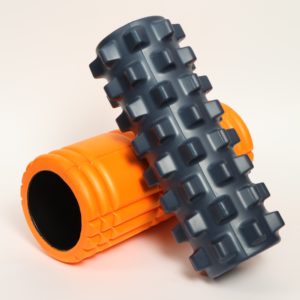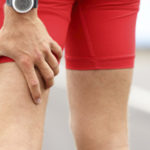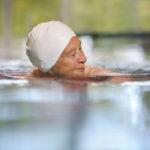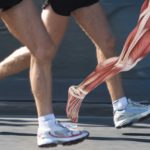Anatomy and Function of the Hamstring
By CEO Robert Forster, PT
In spite of the reputation as being one of the most common and difficult injuries to fix in all of sports medicine, hamstring strains are not all that difficult to rehabilitate. In our work with Olympic sprinters, hurdlers and jumpers, preventing and treating hamstring strains is the most important and valued skill because of the prevalence of these injuries in their events. The three muscles of the hamstring group from medial to lateral: the semimembranosus, semitendonosis, and biceps femoris, all originate via a common tendon at the ischial tuberosity, the bony prominence at the base of the pelvic bone that is the contact point when we sit. They insert on the back side of the lower leg bone (tibia) just below the knee joint.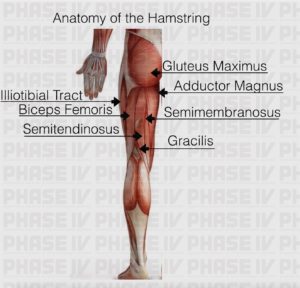
Because this muscle group crosses both the hip and knee joints they are known as two joint muscles. During running the lower hamstring works in a lengthening (eccentric) contraction at the knee joint to slow down the rate that the lower leg swings through the air before it hits the ground. At the hip the upper hamstring works at first eccentrically to limit the degree that the hip joint flexes at foot strike, this helps to slow the speed that your center of gravity drops in mid stance. Later in stance phase they switch function and are active in a shortening (concentric) contraction to extend the hip joint and catapult your body weight over the stationary stance leg. The hamstrings, along with the gluts are the prime movers, (i.e.your motor) in steady state running on flat surfaces as they are responsible for keeping your center of gravity moving forward. In up hill running and sprinting they are even more active.
Presentation of Pain
The pain from hamstring injuries can present in different areas in the back of the body extending from the gluts to behind the knee. This makes self diagnosis difficult. Many runners experience pain in the upper end of the hamstrings very close to the origin at the ischial tubersosity, and some imagine they have torn the upper attachment off the bone. As strong as this muscle group is, it rare that it’s tendon is pulled off of the bone. Instead, with careful examination the muscle strain is found to be an 2-4 inches below the origin.
The difficulty in localizing the exact site of hamstring strain is further illustrated by how often a runner will come in for Physical Therapy evaluation complaining of a hard to locate pain behind the knee. After ruling out knee pathology, the pain is invariably found anywhere in a region from the mid belly of the hamstring to 4-6 inches above the knee even though the pain is experienced lower in the back of the knee.
To further complicate the pain presentation of hamstring strains, there exists a bursa in the gluteal area that will refer pain and tightness into the back of the thigh where the hamstrings are located. A bursa is a fluid filled sac, much like an internal blister; but it’s suppose to be there, and it functions to prevent friction between the gluteus maximus muscle and the sit bone (ischial tuberosity). This condition is called an ischial-gluteal bursitis. It is almost always associated with hamstrings strains, but may exist in isolation too. The tell tale sign of this bursitis is pain with sitting, especially in the car. In the car the pain will be either right under the “sit bone” but often radiate into the hamstring in the back of the thigh making it tight and sore. It may also hurt when sitting on soft or hard surfaces too.
If you are experiencing the sitting pain in the buttock, and it’s worse when sitting in the car, the bursitis needs to be resolved or the hamstring injury will not get better. The pain from the bursa will keep the hamstring tight. If your stretching and icing techniques are performed twice a day and does not resolve the buttock pain, you will need to consult a Physical Therapist who is experienced with running injuries.
Differential Diagnosis
There are at least two other common ailments that will also refer pain to the posterior thigh where a hamstring muscle strain would be experienced and well. Also a compressed nerve root in the low back (lumbar spine) will cause a radiating pain into the hamstring as will a spasm of the Piriformis muscle deep in the buttock.
The Piriformis muscle is one of six “deep rotators” of the hip joint that act mostly as stabilizers during running. When there exists a functional or structural leg length discrepancy, the two lower extremities will not function symmetrically and these deep rotators will often react with a painful spasm that will mimic a hamstring strain. Each of these diagnoses must be ruled out by an experienced physical therapist before an isolated hamstring injury is identified and resolved.
Mechanism of Injury
The hamstrings are subject to both acute and overuse injuries.
Since the hamstrings are the motor that keeps runners moving forward they are highly susceptible to fatigue and a subsequent breakdown of normal function. As described above, the hamstrings work at both the hip and the knee joint during running and function quite differently at each.
In overuse hamstring strains fatigue accumulated during a workout will interfere with the smooth transition from a lengthening contraction to a shortening contraction and the result is muscle fiber damage. As the fatigued muscles struggle to gradually release their contraction and lengthen, they suffer micro trauma that will over time build up to become a macro trauma.
In the interim, the body attempts to repair the damage with scar tissue. After repeated failed attempts to heal the damage, the excess and dysfunctional scar tissue becomes a problem. The scar tissue prevents the muscle fibers from contracting because to do so muscle fibers need to shorten and spread apart, the scar tissue prevents that normal function. The resulting muscle weakness not only decreases performance but can lead to an acute strain.
In overuse injuries as the area of damage and scarred tissue accumulates, the muscle gets tighter and weaker and a dull ache will appear during or after a workout. You will lose your ability to stretch, and attempts to do so only increase the muscle tightness. It turns out that the the scar tissue matrix acts just like one of those Chinese finger handcuffs that tighten around your fingers when you pull the two ends apart from one another. This is one of the few injuries that we don’t stretch in rehab until the scar tissue is resolved.
Alternately, acute traumatic hamstring injury occurs when the muscle is overloaded and a significant number of fibers tear all at once. The pain can be severe and appears suddenly during a workout. This is the type of strain that causes runners to “pull up” in the middle of a race.
Muscle strains are graded I, II, and III to indicate their severity. A grade I strain is when a limited number of fibers are disrupted. You may feel soreness after a workout and/or stiffness when you stretch. If left untreated, a grade I strain will progress to a grade II.
A grade II strain involves a more significant portion of the muscle fibers and the pain is more severe; you will likely limp home. In some instances the damage also involves the fascia, a connective tissue sheath that wraps around the muscle belly.
The acute pain involved with grade II strains will make walking and daily activities difficult for up to 10-14 days or even longer. Also, black, blue and sometimes yellow bruising may appear further down the thigh from the injury sight 3-7 days post injury, as it drains through the superficial tissues.
Grade III strains involve a complete rupture of the muscle or tendon. Grade III strains are rare. The pain and inability to walk or even contract the hamstring will speak to the severity of a grade III strain.
Rehabilitation Program
Whether you have suffered an acute traumatic muscle strain or an overuse injury, the rehab program is similar. Only the timing is different. In both instances the inflammation must be addressed and the scar tissue has to be broken up. Finally the muscle has to be rehabilitated to full flexibility, strength and endurance before sports specific workouts can begin.
In acute injures the inflammation is more significant and is the focus of the first week of rehabilitation. Ice, compression and gentle range of motion exercises begin to move the injury in the right direction. For elite athletes with an imminent competition we will begin treating the scar tissue with cross fiber friction massage quite early, i.e in 48-72 hours post injury.
Cross fiber friction massage is the single most important manual therapy technique used in our approach to sports injuries. This treatment involves the use of specific massage strokes applied in a direction perpendicular to the direction of the tendon or muscle fibers to disrupt the scarring that develops between fibers and prevents normal function.
Because cross fiber friction aids recovery we developed home use massage sticks like this one for daily use.
To fight the lingering inflammation from the injury and to limit further inflammation created with the cross fiber massage techniques, liberal icing as well as the use of ultrasound and electrical stimulation play an important role. For the recreational runner the urgency to address the scar tissue before 72 hours is not an issue so the R.I.C.E. acronym should guide the early phase of the rehabilitation process: Rest, Ice, Compression, Elevation.
Once the acute pain and inflammation has subsided the rehabilitation programs for acute and overuse hamstring injuries proceed on the same path. In addition to cross fiber friction massage we instruct the injured runner to address the scar tissue with use of the massage stick and foam roller, and continue to use ice to control the initial inflammation and the inflammation subsequently created by breaking up the scar tissue.
Compression, via a wrap of self grip tape or a neoprene thigh sleeve, not only helps resolve swelling, but will support the damaged tissue and reduce pain. Light resistance exercises begin only if they can be performed without pain.
Unlike rehab programs for almost all other injuries we do not begin to stretch an injured hamstring until the scar tissue is resolved.
Once the scar tissue is cleared up, the rehabilitation program is directed at regaining full strength, flexibility and endurance. Cross training that can be performed without pain is introduced as tolerated to maintain fitness as the muscle is re-strengthened with a progressive resistant exercise program.
Stretching is introduced once the scar tissue is completely resolved. Only after full strength and flexibility is re-gained can sport specific workouts resume. At first workouts consist of walking alone, then workouts alternating between a walk and a run are used to ease back into training. Mileage is increased by no more than 10% per week. Continue icing until you are back for full training and use the foam roller to continue to fight scar tissue and prevent re-injury.
If you suffer pain in the back of the thigh during or after workouts, consider yourself injured. Cut your mileage in half, stop speed work and hill running, and ice three to five times per day with ice cubes and water in an bag (gel packs don’t work.)
Call Forster Physical Therapy: 310-656-8600 and schedule a free injury evaluation.





